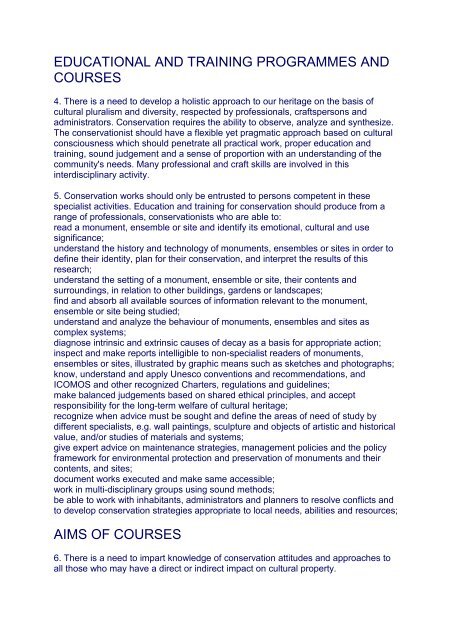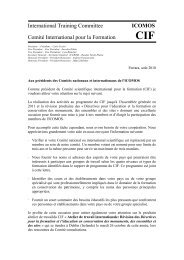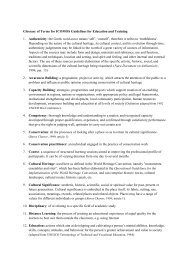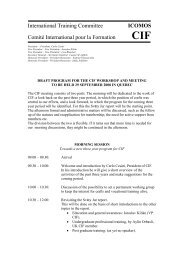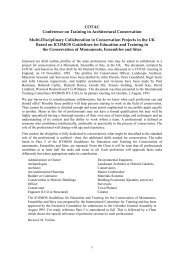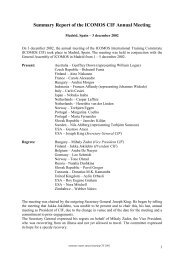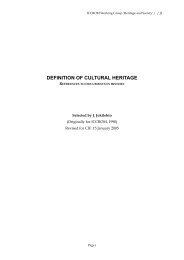guidelines for education and training in the ... - CIF - Icomos
guidelines for education and training in the ... - CIF - Icomos
guidelines for education and training in the ... - CIF - Icomos
You also want an ePaper? Increase the reach of your titles
YUMPU automatically turns print PDFs into web optimized ePapers that Google loves.
EDUCATIONAL AND TRAINING PROGRAMMES AND<br />
COURSES<br />
4. There is a need to develop a holistic approach to our heritage on <strong>the</strong> basis of<br />
cultural pluralism <strong>and</strong> diversity, respected by professionals, craftspersons <strong>and</strong><br />
adm<strong>in</strong>istrators. Conservation requires <strong>the</strong> ability to observe, analyze <strong>and</strong> syn<strong>the</strong>size.<br />
The conservationist should have a flexible yet pragmatic approach based on cultural<br />
consciousness which should penetrate all practical work, proper <strong>education</strong> <strong>and</strong><br />
<strong>tra<strong>in</strong><strong>in</strong>g</strong>, sound judgement <strong>and</strong> a sense of proportion with an underst<strong>and</strong><strong>in</strong>g of <strong>the</strong><br />
community's needs. Many professional <strong>and</strong> craft skills are <strong>in</strong>volved <strong>in</strong> this<br />
<strong>in</strong>terdiscipl<strong>in</strong>ary activity.<br />
5. Conservation works should only be entrusted to persons competent <strong>in</strong> <strong>the</strong>se<br />
specialist activities. Education <strong>and</strong> <strong>tra<strong>in</strong><strong>in</strong>g</strong> <strong>for</strong> conservation should produce from a<br />
range of professionals, conservationists who are able to:<br />
read a monument, ensemble or site <strong>and</strong> identify its emotional, cultural <strong>and</strong> use<br />
significance;<br />
underst<strong>and</strong> <strong>the</strong> history <strong>and</strong> technology of monuments, ensembles or sites <strong>in</strong> order to<br />
def<strong>in</strong>e <strong>the</strong>ir identity, plan <strong>for</strong> <strong>the</strong>ir conservation, <strong>and</strong> <strong>in</strong>terpret <strong>the</strong> results of this<br />
research;<br />
underst<strong>and</strong> <strong>the</strong> sett<strong>in</strong>g of a monument, ensemble or site, <strong>the</strong>ir contents <strong>and</strong><br />
surround<strong>in</strong>gs, <strong>in</strong> relation to o<strong>the</strong>r build<strong>in</strong>gs, gardens or l<strong>and</strong>scapes;<br />
f<strong>in</strong>d <strong>and</strong> absorb all available sources of <strong>in</strong><strong>for</strong>mation relevant to <strong>the</strong> monument,<br />
ensemble or site be<strong>in</strong>g studied;<br />
underst<strong>and</strong> <strong>and</strong> analyze <strong>the</strong> behaviour of monuments, ensembles <strong>and</strong> sites as<br />
complex systems;<br />
diagnose <strong>in</strong>tr<strong>in</strong>sic <strong>and</strong> extr<strong>in</strong>sic causes of decay as a basis <strong>for</strong> appropriate action;<br />
<strong>in</strong>spect <strong>and</strong> make reports <strong>in</strong>telligible to non-specialist readers of monuments,<br />
ensembles or sites, illustrated by graphic means such as sketches <strong>and</strong> photographs;<br />
know, underst<strong>and</strong> <strong>and</strong> apply Unesco conventions <strong>and</strong> recommendations, <strong>and</strong><br />
ICOMOS <strong>and</strong> o<strong>the</strong>r recognized Charters, regulations <strong>and</strong> <strong>guidel<strong>in</strong>es</strong>;<br />
make balanced judgements based on shared ethical pr<strong>in</strong>ciples, <strong>and</strong> accept<br />
responsibility <strong>for</strong> <strong>the</strong> long-term welfare of cultural heritage;<br />
recognize when advice must be sought <strong>and</strong> def<strong>in</strong>e <strong>the</strong> areas of need of study by<br />
different specialists, e.g. wall pa<strong>in</strong>t<strong>in</strong>gs, sculpture <strong>and</strong> objects of artistic <strong>and</strong> historical<br />
value, <strong>and</strong>/or studies of materials <strong>and</strong> systems;<br />
give expert advice on ma<strong>in</strong>tenance strategies, management policies <strong>and</strong> <strong>the</strong> policy<br />
framework <strong>for</strong> environmental protection <strong>and</strong> preservation of monuments <strong>and</strong> <strong>the</strong>ir<br />
contents, <strong>and</strong> sites;<br />
document works executed <strong>and</strong> make same accessible;<br />
work <strong>in</strong> multi-discipl<strong>in</strong>ary groups us<strong>in</strong>g sound methods;<br />
be able to work with <strong>in</strong>habitants, adm<strong>in</strong>istrators <strong>and</strong> planners to resolve conflicts <strong>and</strong><br />
to develop conservation strategies appropriate to local needs, abilities <strong>and</strong> resources;<br />
AIMS OF COURSES<br />
6. There is a need to impart knowledge of conservation attitudes <strong>and</strong> approaches to<br />
all those who may have a direct or <strong>in</strong>direct impact on cultural property.


